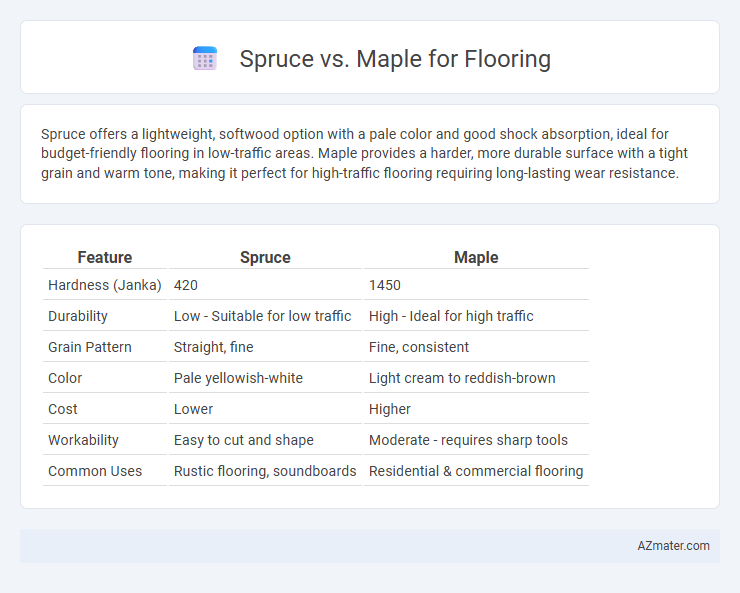Spruce offers a lightweight, softwood option with a pale color and good shock absorption, ideal for budget-friendly flooring in low-traffic areas. Maple provides a harder, more durable surface with a tight grain and warm tone, making it perfect for high-traffic flooring requiring long-lasting wear resistance.
Table of Comparison
| Feature | Spruce | Maple |
|---|---|---|
| Hardness (Janka) | 420 | 1450 |
| Durability | Low - Suitable for low traffic | High - Ideal for high traffic |
| Grain Pattern | Straight, fine | Fine, consistent |
| Color | Pale yellowish-white | Light cream to reddish-brown |
| Cost | Lower | Higher |
| Workability | Easy to cut and shape | Moderate - requires sharp tools |
| Common Uses | Rustic flooring, soundboards | Residential & commercial flooring |
Introduction to Spruce and Maple Flooring
Spruce flooring offers a softwood option characterized by light color tones and a straight grain pattern, providing a warm and natural aesthetic suitable for rustic and contemporary interiors. Maple flooring, a hardwood, is highly durable with a fine, consistent grain and ranges from creamy white to light reddish-brown hues, making it ideal for high-traffic areas due to its resistance to wear. Both Spruce and Maple present distinct visual and performance qualities, with Spruce favored for its affordability and Maple prized for its strength and longevity.
Key Differences Between Spruce and Maple Wood
Spruce flooring offers a softer texture and lighter color, making it ideal for a rustic or natural aesthetic, while maple is renowned for its hardness and durability, providing excellent resistance to dents and scratches. Maple's fine, consistent grain pattern contrasts with spruce's more pronounced knots and grain variations, affecting both appearance and maintenance requirements. The cost of spruce is generally lower than maple, but maple's long-term resilience makes it a preferred choice for high-traffic areas.
Appearance: Color and Grain Patterns
Spruce flooring typically features a pale, creamy color with subtle yellow undertones, offering a lighter, more uniform appearance that highlights fine, straight grain patterns. Maple flooring, known for its durability, presents a creamy to light reddish-brown hue with distinctive, intricate grain patterns ranging from curly to wavy, adding rich texture and visual interest. The choice between spruce and maple can significantly impact interior aesthetics, with spruce providing a soft, understated look and maple delivering a warm, dynamic appeal.
Durability and Hardness Comparison
Maple flooring exhibits significantly higher durability and hardness with a Janka hardness rating of approximately 1450, making it highly resistant to dents and scratches compared to spruce, which has a lower Janka rating around 430. Spruce is softer and more prone to wear, making it less suitable for high-traffic areas or homes with pets and children. Choosing maple ensures long-lasting flooring that better withstands heavy use and maintains its appearance over time.
Installation Considerations for Each Wood
Spruce flooring requires careful acclimation to indoor humidity before installation due to its high moisture sensitivity, ensuring stable expansion and contraction. Maple, known for its hardness and density, demands specialized cutting tools and precise nailing techniques to prevent splitting during installation. Both woods benefit from professional-grade adhesives and fasteners to optimize durability and longevity in flooring applications.
Maintenance and Care Requirements
Spruce flooring requires regular sealing and gentle cleaning to prevent dents and moisture damage due to its softer wood grain compared to maple, which boasts superior hardness and durability, making it more resistant to scratches and easier to maintain. Maple flooring benefits from less frequent refinishing and tolerates higher foot traffic with minimal upkeep, requiring only routine sweeping and occasional mopping with a pH-neutral cleaner. For long-term care, maple's dense cellular structure reduces the absorption of spills and stains, while spruce demands prompt cleanup to avoid lasting damage.
Cost Analysis: Spruce vs Maple
Spruce flooring typically costs less per square foot than maple, making it a more budget-friendly option for large projects. Maple's higher price reflects its greater density and durability, contributing to longer-lasting flooring with better resistance to dents and wear. When comparing total cost of ownership, maple may offer better value due to reduced maintenance and replacement expenses over time.
Environmental Impact and Sustainability
Spruce flooring is often favored for its rapid growth and renewability, making it a more sustainable option compared to maple, which has a slower growth rate and higher density. The carbon footprint of spruce is generally lower due to its lightweight nature and less intensive harvesting processes, promoting better environmental outcomes. Maple, while durable and long-lasting, typically requires more energy for processing and transportation, increasing its overall environmental impact.
Best Use Cases: Where Each Wood Excels
Spruce flooring excels in environments requiring lightweight, affordable, and softwood options, making it ideal for rustic cabins, casual interiors, and areas with minimal foot traffic. Maple's dense, durable hardwood properties make it perfect for high-traffic spaces such as kitchens, hallways, and commercial settings, offering superior resistance to dents and scratches. Both woods have distinct grain patterns and hardness levels, with spruce providing a warm, natural look and maple delivering a sleek, smooth finish suitable for modern and traditional decor.
Conclusion: Choosing the Right Flooring for Your Home
Spruce flooring offers a lightweight, softwood option with a pale, consistent grain ideal for rustic or Scandinavian-style interiors, while maple provides a durable, hard hardwood with tight grain patterns that withstand high traffic and resist dents. Homeowners seeking long-lasting, resilient floors in busy areas benefit from maple's hardness rating of about 1450 on the Janka scale, compared to spruce's softer rating around 520. Selecting between spruce and maple flooring ultimately depends on desired aesthetic, durability requirements, and maintenance preferences to ensure the flooring complements both lifestyle and interior design.

Infographic: Spruce vs Maple for Flooring
 azmater.com
azmater.com